How to Build a Real Estate Website from Scratch

If the simple thought of building a personal or business website sounds intimidating, we have good news: It's something you can easily accomplish. Even if you don’t have any programming skills or you don’t consider yourself to be tech-savvy.
Creating a beautiful real estate website can be a daunting task. However, with today's tools and resources, building your website from scratch is as easy as getting a Netflix subscription. Of course, you may have hundreds of questions at this point: what features to include and how to make it user-friendly or stand out among your competitors.
This step-by-step guide will walk you through everything you need to know to create a successful real estate website. From choosing the right platform and creating engaging content to optimizing it for search engines and promoting - we’ve got you covered.
1. Identify your target audience and ideal customer
One of the essential steps in creating a successful real estate website is identifying your target audience and ideal customer. You need to know who your audience is to create a website that resonates with them and encourages them to engage with your business.
Start by considering the type of property you specialize in, your location, and your target demographic. For example, if you focus on luxury properties in a specific area, your target audience would likely be affluent individuals interested in upscale living.
Once you clearly understand your target audience, thinking about your ideal customer is crucial. Who is the perfect person you want to attract to your website and work with regularly? This can include age, income, interests, and lifestyle.
Why is it so important?
By identifying your target audience and ideal customer, you can tailor your website's design, messaging, and content to appeal to them directly. This will not only help you to attract the right people to your website, but it will also position you as an expert in your area of specialization and help to build trust with potential clients. The more specific you can be, the easier you’ll be able to decide how to make your website.
2. Choose a domain name and website hosting service.
Your domain is your home base on the Internet and the signpost that allows the world to find you. It is what people will type into their web browsers to find your real estate business. Think of it as your online identity. It should be easy to remember, easy to spell, and easy to pronounce.
Ideally, your domain name should include your business name or a relevant keyword that describes your business because most prospective home buyers aren’t searching for YOU: they’re seeking properties and often narrow their search to local areas. They won’t type in a browser “Tom Agent real estate.” Instead, they’re typing “Chicago homes for sale” and “houses for sale in Boston.”
Remember, your domain name and website hosting service are the foundation of your real estate website. Choose wisely, and you'll be on your way to creating a winning website that attracts and converts visitors.
In some online website builders, such as Placester, using your domain name for your website is recommended. If you don’t have a domain name yet, you’ll be provided with a free subdomain name on a sign-up to get started immediately.
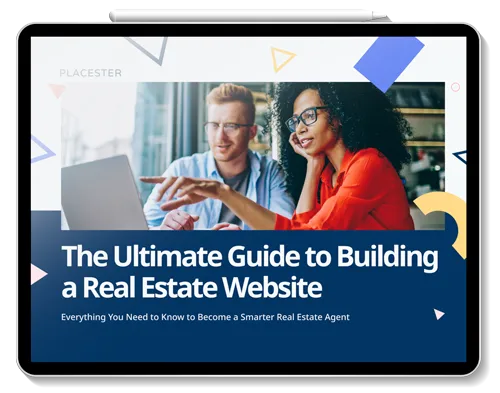
3. Select a web design that fits your brand
Your website is one of the best tools for establishing your brand. It highlights all of the major elements of brand identity:
- logos,
- typography,
- color,
- packaging of products or services,
- content
Successful real estate websites should blend each of these elements - as together, and they showcase your brand's personality. It has to be consistent, especially when your business is new, or you want to attract new customers to your brand. Cluttered headers, ugly color schemes, and confusing (or broken) navigation links are all things that can cause visitors to bounce from your site and move on to a competitor.
5 Tips for Making Your Website Pop
1. Let your logo guide the colors you choose for your site.
2. Play with saturation and brightness
3. Use a complementary color
4. Just don’t go TOO crazy with colors
5. Pay attention to contrast.
People feel drawn to various brand aesthetics, from the graphics style to the color scheme. You’ll even connect with different people depending on whether your brand is formal or informal, contemporary or classic, etc.
Pro tip: Keep the color, font, and graphic style the same across your pages. You can still vary the layout and image choices, but your brand identity will stay consistent this way.
4. Decide on key website components
We’ve been surfing the web for some time now, and because of that, we have some browsing habits, which means that we expect certain website elements to be in certain places.
- Map out your site: your home page is at the center, and different pages branch out. You must also know how to move site visitors from one page to another. Site maps are also necessary for the designer as they need to know the depth and structure of the site.
- Start with a Main page (your landing page), and work on the Navigation Menu. Your main goal is to make the site intuitive, easy to navigate, and descriptive of your business. Pay attention to the following:
HEADER
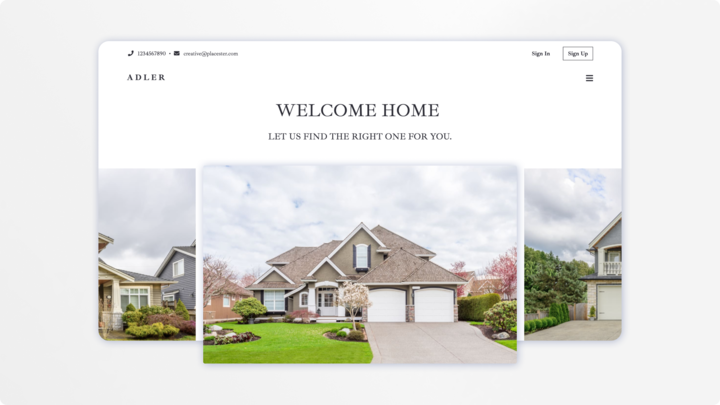
- Show your logo. Use a transparent design so it looks good on different pages and graphics.
- Add your Unique Value Proposition. One of the most meaningful pieces of advice that new real estate agents get is to create a unique value proposition, or UVP, which helps articulate why a buyer or seller might want to hire you.
- Add navigation links. Make it easy for visitors to get around your site and find what they want by including navigation links in your header.
- Add contact information. Including your email address and/or phone number in the header makes it convenient for folks to reach out to you, as they won’t need to navigate to your contact page to find your contact info.
FOOTER
.png)
- Fill in the footer. It is more than just a container for copyright notices and credit links; however, they are important for SEO reasons. Display contact info and/or social buttons.
- Social buttons. Give your visitors every opportunity to connect with you through their social networks by putting Facebook, Twitter, LinkedIn, Instagram, and Pinterest.
- Show your badges, partnerships, and associations logotypes if you belong to any of them.
- Prepare an “About us” page with information about your company or add a professional biography. Tell clients about the services you provide - one of the most enjoyable parts of creating a website - even more so when you use a drag-and-drop website builder like Placester.
- Showcase customer testimonials and reviews to build trust and recognition. Some clients put more faith in testimonials than others. Still, a certain number of buyers and sellers enjoyed working with you enough to take the time to express their gratitude in writing. You should start collecting reviews immediately - it is better to have just a few than none.
- Integrate a lead capture system to generate leads
One of the most important aspects of any real estate website is the ability to generate leads. After all, without leads, you won't be able to close any deals, and your website will not make any money for you.
You need to integrate a lead capture system into your website to capture leads. This can be done in several ways, including using a contact form, offering a free consultation, or providing a newsletter sign-up form. They would work for you as a call-to-action (CTA). Website visitors who want more information will need a way to do so, and contact forms can be hassle-free for a conversation.
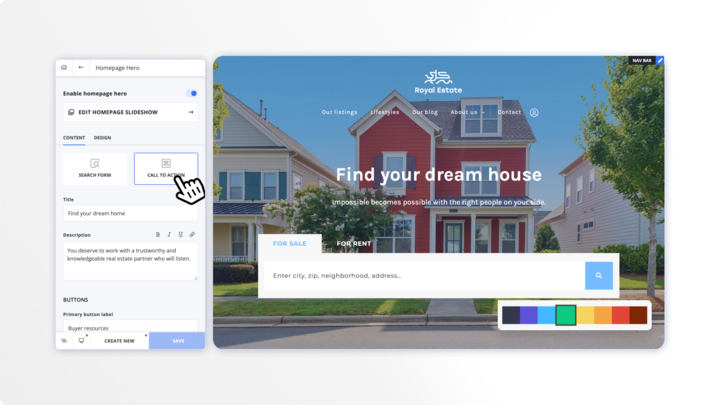
Adding a form as a sidebar option is convenient for inviting visitors to ask questions or start discussions. People enter their name and email address (possibly to access downloadable content or receive a discount code) or contact data so that you can contact them with more information or offer a free consultation.
Some agents send newsletters about local happenings, real estate news, or any other relevant knowledge and insights about the area. Embedding a newsletter sign-up box into your website is a fantastic way to capture new subscribers and give your website visitors an easy way to keep in touch with you. You can create and manage your newsletter using tools like Mailchimp or Constant Contact.
No matter your chosen method, ensuring your lead capture system is prominently displayed on your website is important. You can use pop-ups, banners, or a call to action on your homepage to encourage visitors to become leads. With a custom lead capture system, you can generate more leads and close more deals.
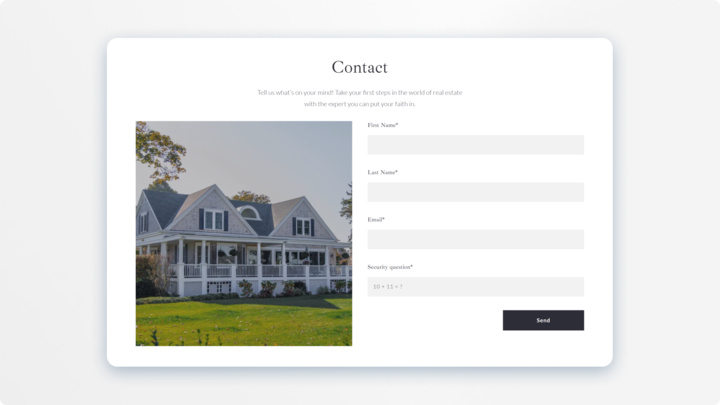
- Chatbox
Sometimes, waiting for a real estate agent to respond is not the ideal solution from a client's perspective. Also, many buyers and sellers fear getting spammed incessantly if they immediately offer up an email address or phone number. Depending on your visitors’ needs, your chat service might offer some pre-written scripts for common questions, or perhaps you’ll find it worth the expenditure to have a live human who can provide white-glove service on the other end of that chat box.
Do your best to keep the most important information and key messaging above the fold (the invisible line on a page dividing what you see first from what you must scroll to see). More details can go below the fold, but keep the design clean and uncluttered.
5. Essential components every agent's website needs
- Property search feature (IDX)
A comprehensive property search feature (IDX) is one of the most important things about a successful real estate website. This is what potential buyers will use to browse through your listings and find the homes they are interested in. They will want to search local homes for sale, and thanks to the beauty of IDX, you can (and should!) give them the option to find those homes without leaving your pages.
When you design a property search feature, remember your target audience. If you focus on first-time home buyers or renters, your search feature may need to prioritize affordability, location, and features like access to public transportation. You may also include advanced search options that allow users to filter by specific features or amenities.

- Create a “Coming Soon” listing page.
You’ll want to make sure your “coming soon” page complies with your MLS and brokerage guidelines, of course — giving buyers a glimpse into the homes that haven’t quite hit the market yet (but are about to) will be well worth the attention to regulatory detail!
- Sold listings
They are records of properties that have been sold and their transaction process has been completed. Showcasing them on your site can help potential clients in the decision-making process, show off your success and build credibility.
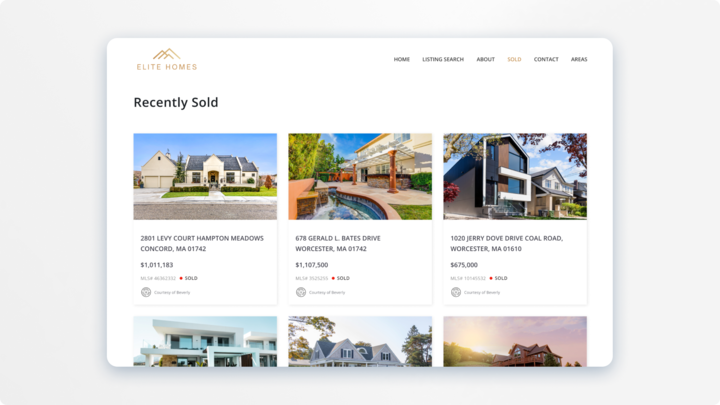
- Insight into the local market.
House prices vary in different areas, depending on demography, neighborhood, and access to schools, facilities, and transportation. When designing your property search feature, it's important to consider the needs of your target audience. For example, if you specialize in luxury homes, your search feature may need to include filters for things like square footage, number of bedrooms, and high-end amenities like swimming pools and home theaters.
- Automated home valuations are useful to include on your website: sellers can instantly answer how much their property is worth. It should come with advice on maximizing their profit and margin.
6. Choosing a Real Estate Website Design Solution
Now that you understand the importance of web design and layout, how do you create an amazing website? As you have the basics covered, it is time to decide on website design. If you just starting, a good option is an online website builder, as it is very straightforward.
Best for: total beginners with no web development experience.
Key features: hosting included, no-code interface, ready-made templates, visual builder.
Website examples: portfolio, real estate website, event website, blog, business website
Website builders come in different shapes and sizes, but most solutions belong to two broad categories: personalized or custom websites.
Placester offers DIY template websites for hands-on users, while if you want to delegate things, you can choose more customized DIFM websites.

What’s the best choice: custom design or DIY templates?
- Custom
A custom site is created “from scratch” because a web designer starts with a blank canvas and builds a site according to a client’s specifications. With a custom site, you’re getting something that’s entirely unique. However, web designers are often expensive, and the design process can take months.
PROS:
- you’ll stand out from the crowd
- you’re in complete control of how your website functions
- You can fully express your branding
CONS:
- it’s an investment
- requires a website designer
- custom website design isn’t an overnight solution
- Personalized
In comparison, a personalized site starts with templated design, which you can add to and adjust. With a personalized site, you can add your logo, change the color scheme, create your navigation links, and add widgets to sidebars and other areas of your site.
PROS:
- it’s fast and easy
- it doesn’t cost much
- do-it-yourself option
- it has a structure
CONS:
- user functionality is limited
- it is based on a template

Some of the best real estate websites often use premade site templates that offer a relatively unique theme. Of course, you can slightly customize them aesthetically (e.g., with your distinct brand logo). You can showcase listings from your MLS on your site in the form of a unique IDX feed.
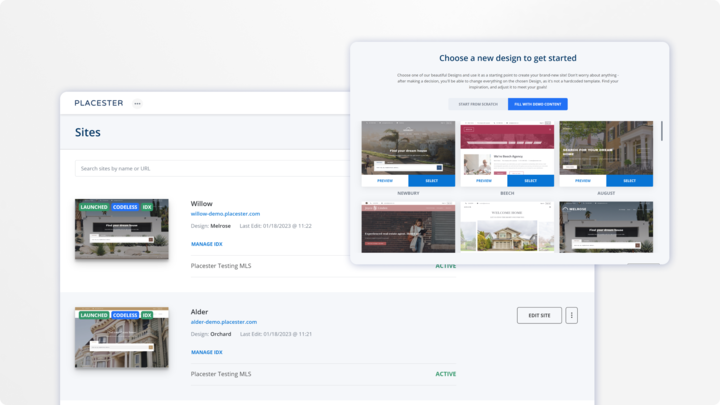
Design your website with a user-friendly layout
Your website should be easy to navigate, with a clear and concise menu that directs visitors to your listings, blog, and other important pages.
When you build your website with Placester, you can select from various template designs, designer-approved fonts, and color palettes. You can customize the font and color scheme to match your brand aesthetic.
A responsive design is one of the most important elements of a user-friendly layout: your website should be visually appealing and easy on the eyes. Use a clear color scheme, and choose legible fonts. Avoid cluttering your pages with too much text or images, which can overwhelm visitors and slow them down. They will soon become frustrated if your website takes too long to load and may leave before they even get a chance to see your listings. Instead, use white space and simplicity to your advantage, which will help draw attention to your page's most important elements.
7. Integrate the CRM system
Once you get some leads, it is good to be able to funnel them and organize everything in the form of a simple database, which you can use at any time. The answer to this is a CRM system or customer relationship management software.
CRMs help agents and brokers keep track of everyone they meet and everyone who visits their website to learn about homes for sale, home values, or other information about real estate transactions. By segmenting buyers, sellers, homeowners, and renters, agents can identify the information and resources most beneficial to each group.
All Placester plans include a simple CRM and the possibility of preparing email marketing campaigns. We also integrate with dozens of CRMs if you have one you already love.
8. Optimize your website for search engines (SEO)
Your prospective buyers and sellers usually don’t know much about you. They don’t know you even exist. Optimizing your real estate website for search engines is crucial to ensure potential clients can easily find your website and that it will appear high up in the search rankings.
When they hear the term SEO or “long-tail keywords,” most people panic but don’t be scared. Start with keyword research related to your real estate niche. This will allow you to identify the most commonly searched-for keywords in your industry and then use those keywords strategically throughout your website's content.
Here’s how to begin researching keywords for your real estate website:
- Use Google Keyword Planner. It’s a free tool and, though intended to help brands and professionals create ads in AdWords, is extremely helpful in determining the monthly search volume for keywords in your area that relate to your business.
- Make a list of terms you connect with your niche, then enter them in the Keyword Planner (while selecting your particular local market because you are interested in search popularity only in your area) and note their search volume.
- Bucket the keywords into different groups based on their focus. For instance, you can segment groups by neighborhood, listing type (e.g., “homes for sale,” “apartments for rent”), or another classification.
Google Keyword Planner is not the only solution available on the market. You can compare your results with other tools such as Keyword Surfer, AnswerThePublic, Keyword Sheeter, Keyworddit, QuestionDB, Ahrefs Keyword Generator, SEMrush Keyword Magic Tool, Ubersuggest, Moz Keyword Explorer.
Optimizing your real estate website for search engines is an ongoing process that requires you to continuously update and improve your website's structure, content, and user experience.
9. Plan your real estate website content
Creating quality content relevant to your target audience is another important aspect of SEO. Blog posts, articles, infographics, or other helpful and informative items for your potential clients will attract more traffic to your website and help build your authority and reputation in the industry.
PRO TIP: Don’t become an SEO slave. Your texts should be SEO optimized yet clear and understandable. Filling each blog post and page with meaningless content will have the opposite effect. Write about things close to your readers' hearts. Use nice language (check for typos and misspelled words), and give plenty of real-life examples.
Plan your content: this way, when the busy time of year comes, you will be prepared, and your posts will have continuity and regularity. You can always move things around, delete ideas, and revise them to improve.
If you struggle to be regular, create a comprehensive editorial calendar where you plan the blog post topics and schedule them. Use Google Spreadsheets, dedicated planners such as Hootsuite, or any Project Management tools (i.e., Trello, Hubspot).
10. Utilize social media, email marketing, and paid ads to drive traffic to your website
Your well-thought and planned SEO strategy will work in the long run and hopefully generate organic traffic, but sometimes you need to get off your feet in a matter of days or weeks. That’s why promoting your site content directly to your network through personalized emails, in-depth social shares, and even precisely targeted ads is the best means for near-term lead generation.
Platforms like Facebook, Instagram, and LinkedIn are your first port of call to promote your real estate business and website. Share your listings, blog posts, and relevant content to attract potential customers. Use paid advertising to target specific demographics and increase your reach. If you are still in the dark, use our Real Estate Facebook Ads Guide to get you going.
Email marketing is another effective way to drive traffic to your website. You can send newsletters, property updates, and other information to your email list to keep them engaged with your brand. Make sure your emails are visually appealing and informative and provide value to your subscribers.
11. Monitor and analyze website traffic and performance
After putting in time and effort to create your real estate website, monitoring and analyzing its traffic and performance is crucial. This will give you a better understanding of your website's strengths and weaknesses and areas that need improvement.
One of the best tools for monitoring website traffic is Google Analytics. It's free and easy to set up, and it provides valuable insights into your website's visitors, including their demographics, interests, location, and behavior.
Additionally, you should regularly review your website's performance metrics, such as page load times, bounce rates, and conversion rates. These metrics can show your website's performance and whether it meets your business goals. If you notice any issues or areas for improvement, address them to ensure your website continues to perform at its best.
If you want to know more about users’ behavior, there are more advanced tools that will give you even more proverbial food for thought. Check out apps such as HotJar or Cux.io. Both solutions record users' actions on the website and provide heatmaps, with stress on “angry clicks” and navigation insights. Once you analyze them, you can work to make improvements on bounce rates, UX design, different locations of CTA buttons, or other lead capture forms.
12. Continuously update and improve your website
A real estate website is not a one-time job. It requires continuous updating and improvement to stay relevant and effectively attract potential clients. Trends and market demands are dynamic, and keeping up with these changes is essential to maintaining a competitive edge.
An outdated, slow-to-load, or not mobile-friendly website will quickly turn off visitors and make them go to other real estate websites.
Ensure you regularly update your website's content with relevant, informative, and engaging material targeting your audience. Add new property listings, share informative blog posts, and update your contact information. Encourage visitors to leave comments and feedback and respond to them promptly. This will help you improve your website and build lasting relationships.
Remember, your website is your virtual storefront, and the first impression potential clients have of your business, so maintaining a polished and updated website is essential for success in the competitive real estate market.
Congratulations! You've made it to the end of our step-by-step guide to creating a winning real estate website. By now, you should have an idea of all components of a website that is visually appealing, easy to navigate, and has all the features necessary to impress visitors and convert them into clients. Take things into your hands with a Do It Yourself (DIY) package, or let us create your real estate website with a Do It For Me (DIFM) plan. Best of luck!



.png)


